WHERE IS ME?: AN EXPLORATION OF VOICE IN L2 WRITING AMONG THAI UNIVERSITY STUDENTS
Main Article Content
Abstract
The concept of voice in second language (L2) writing is increasingly recognized as a key aspect of language proficiency, though it remains somewhat elusive and controversial. This study aimed to deepen the understanding of voice in L2 writing among 21 Thai university students. We analyzed their responses to questionnaires, including open-ended questions, using basic statistics and content analysis. The data collection took place in January, 2024. Our results revealed that a significant majority of students found writing in English challenging, and their L2 voice differed from their L1 voice. Additionally, their self-reports indicated distinctions between their written and spoken English. Students expressed a loss of confidence and a sense of disconnection from their true selves when tasked with writing in English. Our findings contribute to the literature on L2 voice in writing, confirming that L2 voice in writing is a multifaceted and contextualized construct. We provide practical recommendations for Thai teachers to assist students in developing their L2 voice. Finally, further research is needed to conceptualize Thai students' voice in English writing.
Article Details

This work is licensed under a Creative Commons Attribution-NonCommercial-NoDerivatives 4.0 International License.
Each publish articles were copyright by Phranakorn Rajabhat University
Any contents which appeared in each articles in the journal were authors personal opinion. It did not relate to Phranakorn Rajabhat University and other instructors in the university. Each authors would take responsibility on their articles. If there are any mistake, the authors will take responsibility themselves
References
Alharbi, M. (2019). Saudi Arabia EFL university students’ voice on challenges and solution in learning academic writing. Indonesian Journal of Applied Linguistics, 8(3), 576-587. doi:https://doi.org/10.17509/ijal.v8i3.15276
Bakhtin, M. M. (2010). The dialogic imagination: Four essays. University of Texas Press.
Camps, D. & Ivanic, R. (2001). I am how I sound: Voice as self-representation in L2 writing. Journal of Second Language Writing, 10(1-2), 3-33. https://doi.org/10.1016/S1060-3743(01)00034-0
Clark, R. P. (2018). Authentic Voice: The Indispensable Quality of Good writing. Retrieved from https://www.poynter.org/reporting-editing/2018/authentic-voice-the-indispensable-quality-of-good-writing/
Elbow, P. (2007). Reconsiderations: voice in writing again: Embracing contraries. College English, 70(2), 168-188.
Hall, E. T. (1976). Beyond culture. New York: NY, Doubleday.
Hyland, K. (2002). Options of identity in academic writing. ELT Journal, 56(4),351-358.
Leki, I. (1997). Cross-talk: ESL issues and contrastive rhetoric. In C. Severino, J. C. Guerra, & J. E. Butler (Eds.), Writing in multicultural settings (pp. 234-244). New York: Modern Language Association.
Matsuda, P. K. (2001). Voice in Japanese written discourse: Implications for second language writing. Journal of Second Language Writing, 10(1–2), 35-53. https://doi.org/10.1016/S1060-3743(00)00036-9
Phothongsunan, S. (2016). Thai university academics’ challenges of writing for publication in English1. Theory and Practice in Language Studies, 6(4), 681-685. https://doi.org/10.17507/tpls.0604.042
Prior, P. A. (2001) Voices in text, mind, and society: sociohistoric accounts of discourse acquisition and use. Journal of Second Language Writing, 1–2, 55–81.
Ramanathan, V. & Atkinson, D. (1999). Individualism, academic writing, and ESL writers. Journal of Second Language Writing, 8(1), 45-75. https://doi.org/10.1016/S1060-3743(99)80112-X
Tan, Bee Tin (ed.) (2004). Creative Writing in EFL/ESL Classrooms I. Serdang: UPM Press.
Tardy, C.M. (2012). Current Conceptions of Voice. In: Hyland, K., Guinda, C.S. (eds) Stance and Voice in Written Academic Genres. Palgrave Macmillan, London. https://doi.org/10.1057/9781137030825_3
Yang, S. & Peng, Y. (2021). I Am Like a Lost Child: L2 Writers' Linguistic Metaphors as a Window Into Their Writer Identity. Front. Psychol. 12:648667. doi: 10.3389/fpsyg.2021.648667


